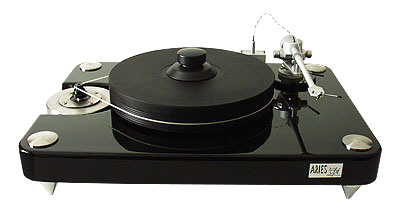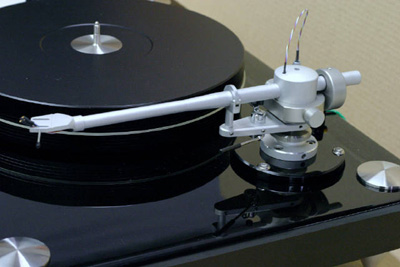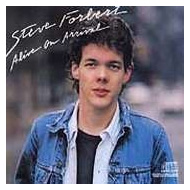|
You are reading the older HTML site Positive Feedback ISSUE 10october/november 2003
vpi "Black Knight" Aries II turntable as reviewed by Larry Cox
|
||
|
|
I wish hearing the phrase "Built Chevy tough" inspired me with the confidence to buy a Chevy, but it doesn’t. It takes more than a catchphrase to make a product. I’d prefer to buy an American car, but Japanese and German vehicles are built better and perform better. My Acura Integra has about 190,000 miles on it, but it still runs and handles like a champ. I’ve spent no more than $1000 on repairs over its twelve years, and the car has been a delight to own. Am I un-American? No. I vote, I pay taxes and I do things that are good for America, but for now, I’m not an American car owner. While American automakers have struggled to produce well built, reliable cars, American audio companies have done very well. VPI stands among the preeminent American audio companies, and certainly among turntable manufacturers. There are other companies that can stake the claim to "best turntable in the world," but few if any have the same cachet as VPI. It seems that everything VPI turns out is well received. They also seem to be in the game for the long haul, so if you need support, they’re likely to be there. An example of this is VPI’s choice of motor for the Aries. Harry Weisfeld chose the Aries motor because it was available from a standard source, so if anything happens to VPI, you’re not stuck. Given that the motor is about the only "moving" part on a turntable, it is about the only thing I can imagine failing. VPI rocketed to the front of magazine attention about twelve or thirteen years ago with their statement piece, the TNT. I presume Mr. Weisfeld thought that the TNT would blow away the competition, and it did for a while, at least in terms of press space. VPI then came up with the Aries, possibly to appeal to those without a back forty in which to stable their turntable (TNTS are large). VPI states on its web page that the Aries provides "near-TNT performance in an HW-19 sized package," the HW-19 being a conventionally sized table. That said, the Aries is still big, the plinth being 22 inches wide by 16 inches deep. A 24-by-18 shelf is required if you plan on using the optional dust cover. Having seen the dust cover, I would pass. The Aries II seems to be a fairly substantial upgrade from the Aries. It uses an inverted bearing, which is to say that the ball bearing on which the platter spins is just below the platter. Given the motor’s pulley action on the platter, the closer your vinyl is to the location of the ball, the less wobble or "teeter totter" action the stylus will encounter. There will still be some wobble, but the greatest wobble is placed at the bottom of the platter and the least will be closer to the plane of the platter. This seems like a good idea. I don’t know who invented it, but I’ve read that the Amazon turntables from Germany have been doing this for at least four or five years. There are currently two iterations of the Aries turntable, the Aries II and the Aries Black Knight. According to VPI’s website, the Black Knight is an Aries II packaged with VPI’s 9-inch JMW arm and a different sized platter at an attractive price. The Aries II retails for $2400 and the 9-inch JMW arm retails for $750, so at $2800 for the pair, the Black Knight saves you $350. Other differences between the Aries II and the Black Knight are mostly cosmetic—the platter on the Black Knight is black instead of clear. On a non-cosmetic note, the Black Knight’s smaller platter will not take VPI’s new record clamp, which fits around the edge of the Aries II platter What do you get for your $2800? You get a heavy, large plinth on which the platter and arm sit. The table itself is two inches of MDF with a steel plate bonded to the bottom. The MDF is finished in piano black and looks really great. Unlike other tables at its price, you get a big, thick (1.75 inches) hunk of black acrylic for a platter. In my review of the JR Transrotor Leonardo turntable, I commented on what I thought was an unfairly high cost for an acrylic turntable. I have come to understand that acrylic is expensive, in which case, VPI has spent some extra bucks giving you a theoretically better noise and vibration-damping platter. The platter has striations on its side, which form the grooves that the Aries belt uses to change the platter’s rotational speed. Raise and lower the height of the motor and you alter the height at which the belt touches the platter, thereby altering the platter’s rotational speed. The Aries therefore seems to have excellent pitch stability, and that’s desirable.
The nine-inch JMW9 arm is the same one used on the Aries Scout, and is one inch shorter than the well-regarded JMW10. As far as I could tell, the JMW9 differs from the JMW10 (other than in length) only in that the JMW10 has a collar at its base which allows for changing VTA on the fly, offering the ability to easily and precisely repeat desired settings. The JMW9 uses two setscrews, so you can adjust VTA easily, but not on the fly. Adjusting VTA on the fly is novel, and it allows you to get the proper setup for each LP, but really, for how long will you be doing this? I think I’d keep my butt in the listening seat and deal with a not-quite optimal setup. If you’re more compulsive than me, you may want the JMW10. I’d be quite happy with the 9. The table is well thought out. Setup is absolutely, brilliantly easy. A friend with far more turntable experience than I offered to set it up for me, but I got itchy to have the table in operation, and tried setting up my old AudioQuest 404i medium-output moving coil cartridge. (It’s older and cheaper than my Koetsu Rosewood, so I figured that if I trashed it, it was time for retipping or replacement anyway.) I followed VPI’s instructions, using their jig to install the arm. I think it took me about ten minutes. I was excited and ready to go, but put a record on that I wouldn’t mind ruining on the off chance that I had screwed up something. I put the needle down… and the arm swept across the record to the spindle without bothering to stop in any particular groove. Damn, I thought, I’ll have to mess with anti-skating. There is no anti-skating control on JMW arms. VPI advises twisting the hookup wire to provide anti-skating. I tried twisting the wiring once, to no effect. I figured that I had twisted it the wrong way, so proceeded to gently twist it in the opposite direction. The arm now skated off the record in the other direction. I went back to the very simple instructions, and over the next hour made no progress whatsoever, though I did a masterful job of worrying that I was going to rip the stylus out of my cartridge. I though I had to be an idiot to not be able to follow the instructions. When I realized how anxious I was, I loosened my belt, shook my shoulders, and took three deep breaths, then undid all the twisting and put the needle down one more time. Arrrrrrrgh! It’s a good thing no one was watching. The problem lay not with the arm setup, which I had done properly, but with the flaccid suspension of the Audioquest cartridge. There was so little support left in the suspension that the bottom of the cartridge made contact with the record and slid across the record. If you don’t follow instructions well, or have the slightest compunction about setting up your cartridge, I recommend that you let someone that knows their stuff do the deed. I was too excited to wait, so on I went. Understanding how easy the setup should be, I decided that I could install my Koetsu. The Koetsu, with its parallel surfaces, was a breeze to set up. I could have been up and running within about five minutes, but I was still a little nervous, so I checked and rechecked the setup at least four times. Finally I took the plunge, and placed the stylus in the groove. Music! My Koetsu sounded great. Just to be sure, I had my more experienced friend check my work, and got a thumb’s up. Nevertheless, all was not well in California, the home of seismic activity. My house doesn’t need an earthquake to start shaking. My listening room is suspended above the first-floor garage, and the joists bounce. If I walked while a record was playing, however gently, my Koetsu would tumble across the record like Olga Korbut. I tried a couple of different resolutions. Luckily I had an opportunity to use a Mana Two Tier rack ($800), and the Mana’s mass managed to tame the Olga Korbut imitations. The sound became quieter, and the blacker backgrounds made for a more intimate musical experience. These racks are underappreciated in the States, but I highly recommend them. Unfortunately, the occasional misstep still caused a frightening cartridge tumble. By good fortune, I was able to borrow a Townshend 3-D Seismic Sink, with its air bladder damping mechanism. Townshend makes a range of these devices. Given the size and weight of the Black Knight, I had to use their largest device, the 3D-HD ($600). With the Townshend, images decoupled from the speakers, and there was more apparent detail than with the VPI sitting on my standard Lovan rack. There was only one very slight downside, which was that the speed and clarity of transients was less apparent. The 3D-HD sitting on the Mana roughly split the difference and provided the best results—excellent image stability, images decoupled from speakers, great attack and decay, and a very quiet background. With the Townshend and the Mana working together, I also had no tumbles, flips, or mistracking from the Koetsu. As an aside, if you are considering the purchase of an unsuspended turntable, you need to factor in the price of ancillaries. With the Mana and the Townshend, you’re looking at significant increases in cost, notwithstanding the fact that the improvements in performance make them worthy the extra money. You can suffer along without them, but suffering sucks, so I don’t suggest you do that, but it means that you don’t just buy an Aries or a Transrotor—you may have to spend more money to optimize their performance. I did my listening with both the Mana and the Townshend. Let me summarize at the outset: The Aries II provided excellent bass and rich, dark tonal colors, but lacked an open or airy treble. Having owned two suspended tables—a Sota Sapphire and an Oracle Delphi MkII—for a total of about ten years, I have come to associate an open and airy top end with a correct presentation. Recently hearing two unsuspended turntables—the Aries and the Transrotor Leonardo—lead me to note that some recordings are airy and some aren’t, and that the SOTA and Oracle tables may have an "airy coloration," one that provides a greater sense of air, etc., but a coloration nonetheless. The Aries Black Knight was rather chameleon-like during its stay with me. It isn’t a "rhythm machine." There was a sense of sound in motion without a particularly strong sense of rhythm. "Jamie’s Cryin" from Van Halen’s first LP had bounce and bombast, but wasn’t particularly rhythmic. The Aries produced the deepest bass I’ve had in my house, more so than even my old Sota Sapphire, which I thought quite good. It easily (perhaps unkindly) let me know that my Audio Note CD 3.1x isn’t a miner for deep, thunderous bass. Sir Adrian Boult performance with the London Philharmonic Orchestra of Elgar’s Sanguine Fan had an excellent "back beat" that provided drama and clarity while remaining low in absolute volume level. Ditto for the weight and impact of Herbert von Karajan’s rendering of Ravel’s Bolero on Mobile Fidelity. Near the end of the piece, there was an excellent sense of an impending crescendo that was unequaled in any system I’ve had. Bass comes with the Aries Black Knight, big time. Unlike the Transrotor or the Basis 1400 (other unsuspended, acrylic tables I’ve listened to), the Aries did not provide treble that sparked sound into life. The Sanguine Fan piece was not quite as light and sweet as it was with my Oracle, or as open sounding as with my Sota Sapphire. The Oracle’s lightness of touch, and its open, yet still forceful sound are available with the Aries, but not as frequently. I think that both tables have coloration. The Delphi amps up the high frequencies, in part because it has a lighter bottom end. The Aries may not have as open a sound because its bottom end is thunderous. The lack of delicacy in the top end made the Aries’ treble a bit harder than I’m accustomed to. My experience was that the Aries could not find that special place between hard and wispy. The Delphi and the Sapphire may have added sparkle and airiness when it wasn’t there. I don’t know, but I am reporting my experience. Whatever the Delphi and Sapphire did, it was closer to what I thought was correct. The Aries didn’t sound as open or as convincing as I wanted. Given the right recording, it could deliver a light, airy, even wispy sound, but it couldn’t deliver this sound as regularly as some other tables.
Imaging was acceptable, but not as rivetingly good as some other turntables have been for me. I’ll say, for the one hundredth time, that I’m not particularly interested in imaging, so if I didn’t get excellent imaging, it may be because I wasn’t willing to work hard for it. Your mileage may vary. Where the Aries really shined was in richness of tone. Listening to Linda Ronstadt’s What’s New, strings were light and delicate, with rich vocal tones. Her lyrics haven’t been the reason to buy her records—it’s her bell-like tone, coupled to a warm resonance, which makes her vocals a special treat. The Black Knight allowed those vocals to come through as well as I’ve heard them in my system. Emmylou Harris’ vocals on Profile were rendered with a significantly less bell-like tone, but with all the emotion her music and lyrics offer. Her longing was palpable. Guitars had an excellent sense of pluck and decay. "Achingly beautiful" sounds like a bad idea, mixing pleasure and pain, but isn’t that how the great moments of our lives sometimes are? The Aries allowed for really great results with Emmylou. Like a lot of high end gear, the Aries is rather ruthless about letting you know whether your source material is great or not. Unfortunately, lots of my records sounded bad. It could be that my system has morphed into a more accurate and articulate setup with less added euphony, and that this was my first opportunity to hear it, but, like the Transrotor, the Aries made some recordings sound undesirable. The Black Knight is very well built. It looks like it will last your lifetime and a few more. It is very easy to set up and use. If it demanded less space, it would be really desirable to me, but it’s still big. In my admittedly bouncy living room, I needed multiple suspension/damping systems to make the table work properly. Though the Aries needed more coddling than I could afford, there aren’t a lot of rooms with joists as bouncy as mine. Slab floors or better suspended floors would be better choices for the Aries Black Knight, but the fit, finish, and truly exemplary setup instructions make the Black Knight an easy recommendation. Larry Cox Black
Knight Aries II turntable and JMW 9 tonearm VPI
|



 One of my all-time favorite recordings is Steve
Forbert’s Alive on Arrival, a record that prompted some wild-ass guessers to
label him as the new Dylan. Dylan doesn’t have Forbert’s light touch. Forbert is
able to express emotion in a way that is humorous yet takes your breath away with its
poignancy. It was a delight to listen to this LP after being without a turntable for a
year. With the Aries, the sound was disappointing. While Forbert tends to sound wispy on
his recordings, here the whole presentation was wispy. I expect that this is the
recording, but the Aries made "Little Stevie" hard to listen to. Caveat emptor.
One of my all-time favorite recordings is Steve
Forbert’s Alive on Arrival, a record that prompted some wild-ass guessers to
label him as the new Dylan. Dylan doesn’t have Forbert’s light touch. Forbert is
able to express emotion in a way that is humorous yet takes your breath away with its
poignancy. It was a delight to listen to this LP after being without a turntable for a
year. With the Aries, the sound was disappointing. While Forbert tends to sound wispy on
his recordings, here the whole presentation was wispy. I expect that this is the
recording, but the Aries made "Little Stevie" hard to listen to. Caveat emptor.